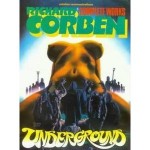
By Richard Corben and various (Catalan Communications)
ISBN: 978-0-87416-018-5
Although he has only infrequently strayed into the comicbook mainstream, animator, illustrator, publisher and cartoonist Richard Corben is one of America’s greatest living proponents of sequential narrative: a stunningly accomplished artist and unique, uncompromising stylist who grew out of the independent counterculture commix of the 1960s and 1970s to become a globally revered, multi-award winning creator.
He is best known for his mastery of the airbrush and delight in sardonic, darkly comedic horror and science fiction tales.
Born in Anderson, Missouri in 1940, he graduated from the Kansas City Art Institute with a Fine Arts degree in 1965 and found work as an animator. At that time, the Underground Commix revolution was just beginning as a motley crew of independent-minded creators across the continent began making and publishing stories that appealed to their rebellious, pharmacologically-enhanced sensibilities and unconventional lifestyles. Most of them were hugely influenced either by 1950s tales from EC Comics or Carl Barks’ Duck tales – and occasionally both.
Corben started the same way, producing the kind of stories that he would like to read, in as variety of small-press publications including Grim Wit, Slow Death, Skull, Fever Dreams and his own Fantagor often signed with his affectionate pseudonym “Goreâ€. As his style matured and his skills developed Corben’s work increasingly began to appear in more professionally produced venues. He began working for Warren Publishing in 1970 with tales in Eerie, Creepy, Vampirella, Comix International and laterally, the aggressively audacious adult science fiction anthology 1984. He also famously re-coloured a number of reprinted Spirit strips for the revival of Will Eisner’s the Spirit magazine.
In 1975 Corben submitted work to the French phenomenon Métal Hurlant and subsequently became a fixture in the magazine’s American iteration Heavy Metal where his career really took off. Soon he was producing stunning adult fantasy tales for a number of companies, making animated movies, painting film posters and producing record covers such as the multi-million-selling Meatloaf album Bat Out of Hell. He never stopped producing comics but always stuck to his own independent projects with collaborators such as Harlan Ellison, Bruce Jones and Jan Strnad.
This regrettably out-of-print collection of those early strip efforts, translated from a European edition by Jim Lisle, features a rather inaccurate introduction by Luis Vigil but boasts a dynamic collection of raw, powerful and wickedly sardonic and whimsical suspense tales in the EC vein that graphically display the artist’s rapid, radical creative development beginning with ‘Heirs of Earth’ (1971), a post-apocalyptic tale of love and cannibalism.
Corben’s infamous signature-stylisation includes lots of nudity, graphic violence and near grotesquely proportioned male and female physiques, none of which are apparent in the tantalisingly low-key spoof ‘Alice in Wanderlust’; an early skit by long-term co-creator Jan Strnad, after which ‘Horrible Harveys House’ (1971) tells an intriguing tale of young lust when film student Jarvis talks his stacked and rather easy girlfriend Zara into visiting an abandoned house to make an “art-movieâ€. Turns out the place isn’t completely empty after all…
From 1970, ‘Twilight of the Dogs’ is a classic sting-in-the-tale saga as Earth’s last surviving free men uncover some rather unfortunate facts about the aliens who conquered them whilst ‘Gastric Fortitude’ displays another side of love. ‘The Dweller in the Dark’ (from a story by Herb Arnold) is an early exploration of Corben’s fascination with and facility for depicting lost civilisations, wherein rain-forest dwellers Bo Glan and Nipta break taboo to explore a dead city only to fall foul of rapacious, invading white men and ancient things far worse…
All the previous yarns were reproduced in black and white: ranging from pen-line to airbrushed monochrome tones but worlds-within-worlds alien romance ‘Cidopey’ reveals its tragic twist in full colour, as does ‘For the Love of a Daemon’ which shows inklings of the artist’s later airbrush expertise in a boisterous black comedy of Barbarians and hot naked babes in distress.
Jan Strnad also wrote the dark dystopian ‘Kittens for Christian’, a moody post-cataclysm thriller with chilling echoes of Corben’s later graphic novel Vic and Blood (an adaptation and extension of Harlan Ellison’s “A Boy and his Dogâ€) before this volume concludes on a light and colourful note in the artist’s 1973 collaboration with Doug Moench: ‘Damsel in Dragon Dress’: a gleeful witches brew of fantasy, fairytale foible – a saucy cautionary tale on the unexpected dangers of drug abuse…
Richard Corben is a groundbreaking and rightfully renowned figure in our art-form and the fact that so much of his work is currently unavailable in English is a disgrace. Not only are his early works long overdue for a definitive re-issue but all his rude, riotous, raucously ribald revels need to be re-released now. Until that time stay tuned…
© 1970, 1971, 1972, 1973, 1985 Richard Corben. © 1985 Catalan Communications. All rights reserved.
